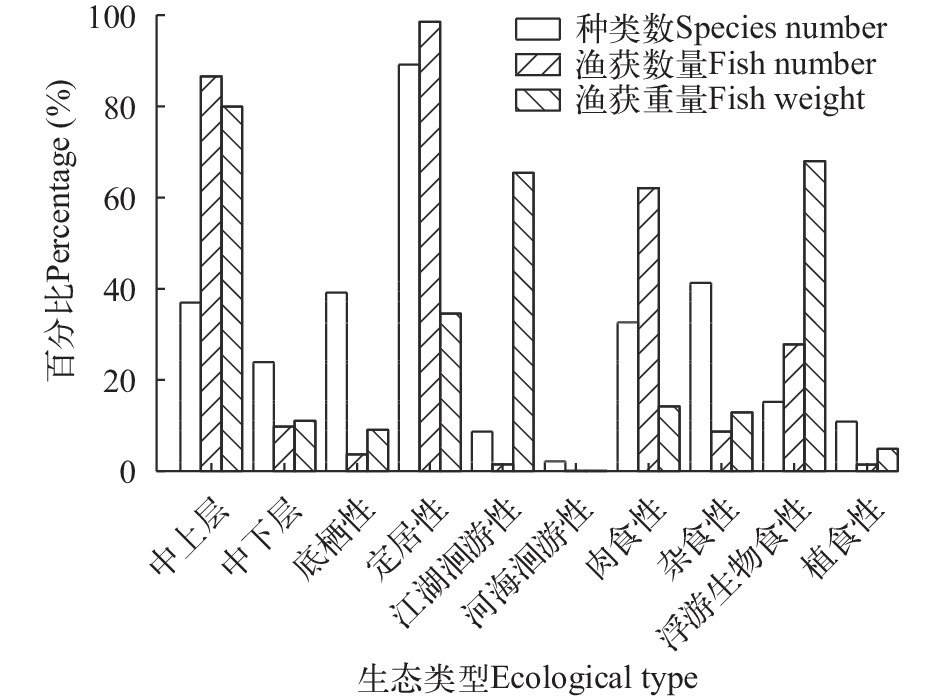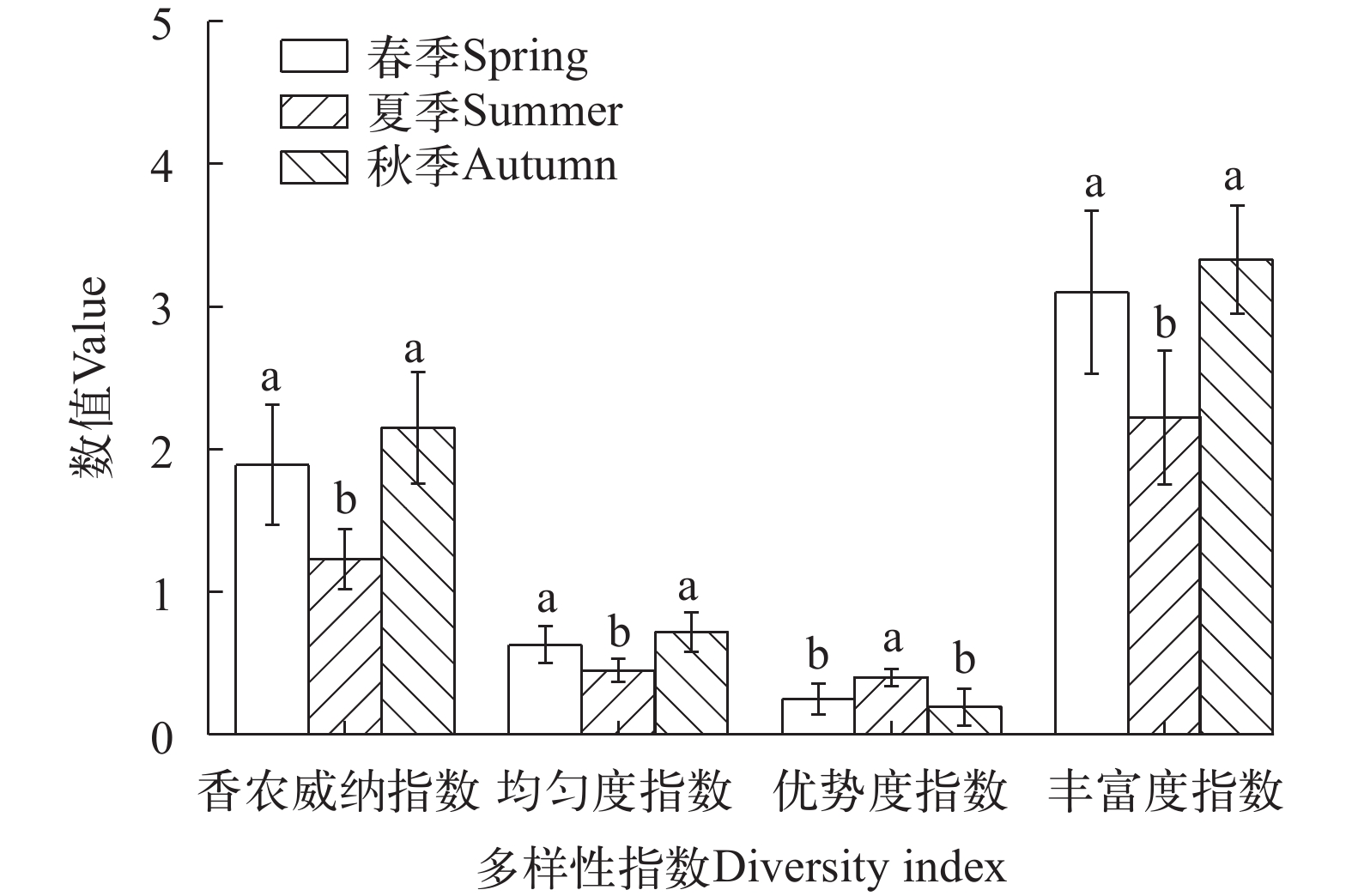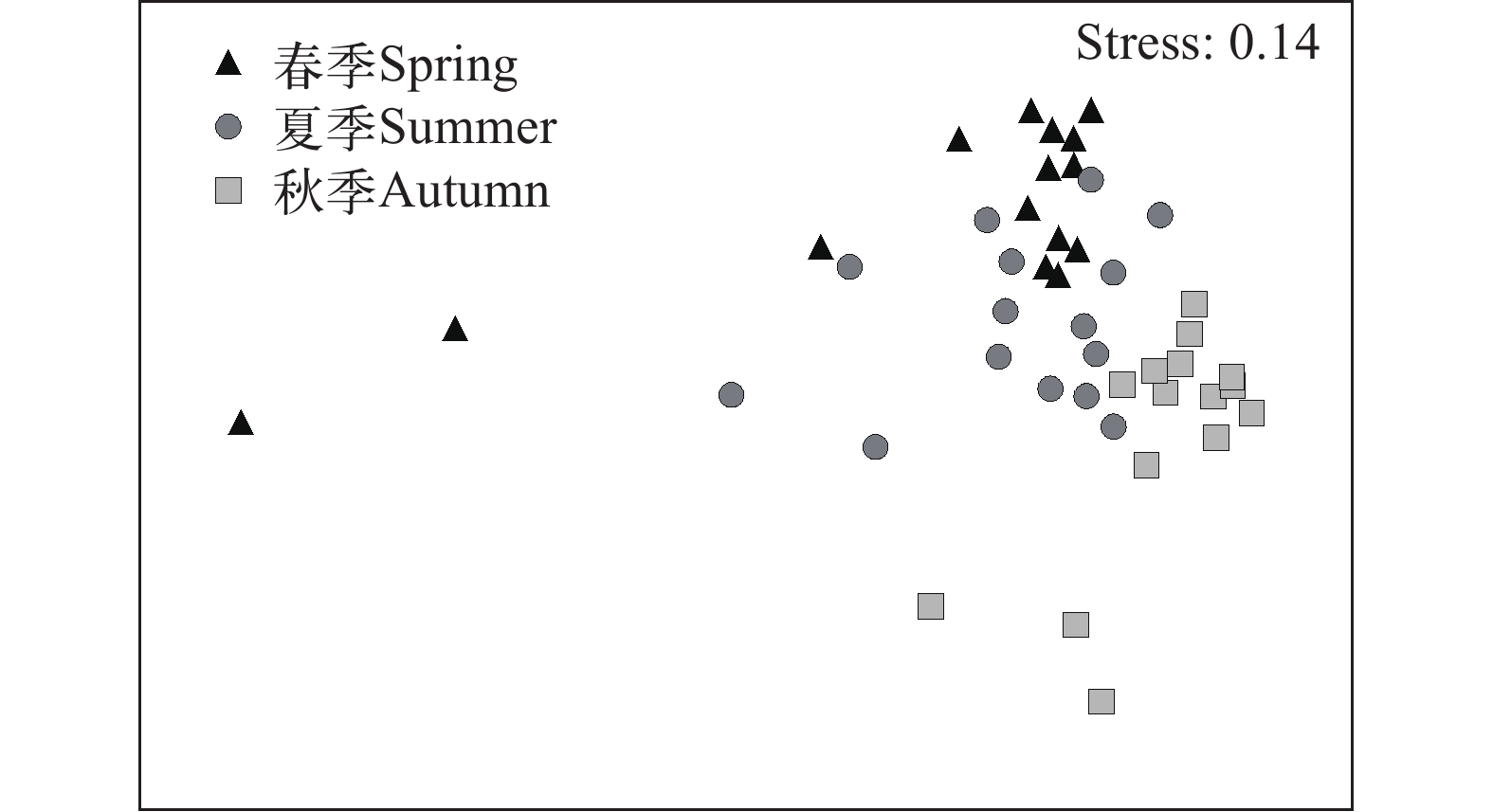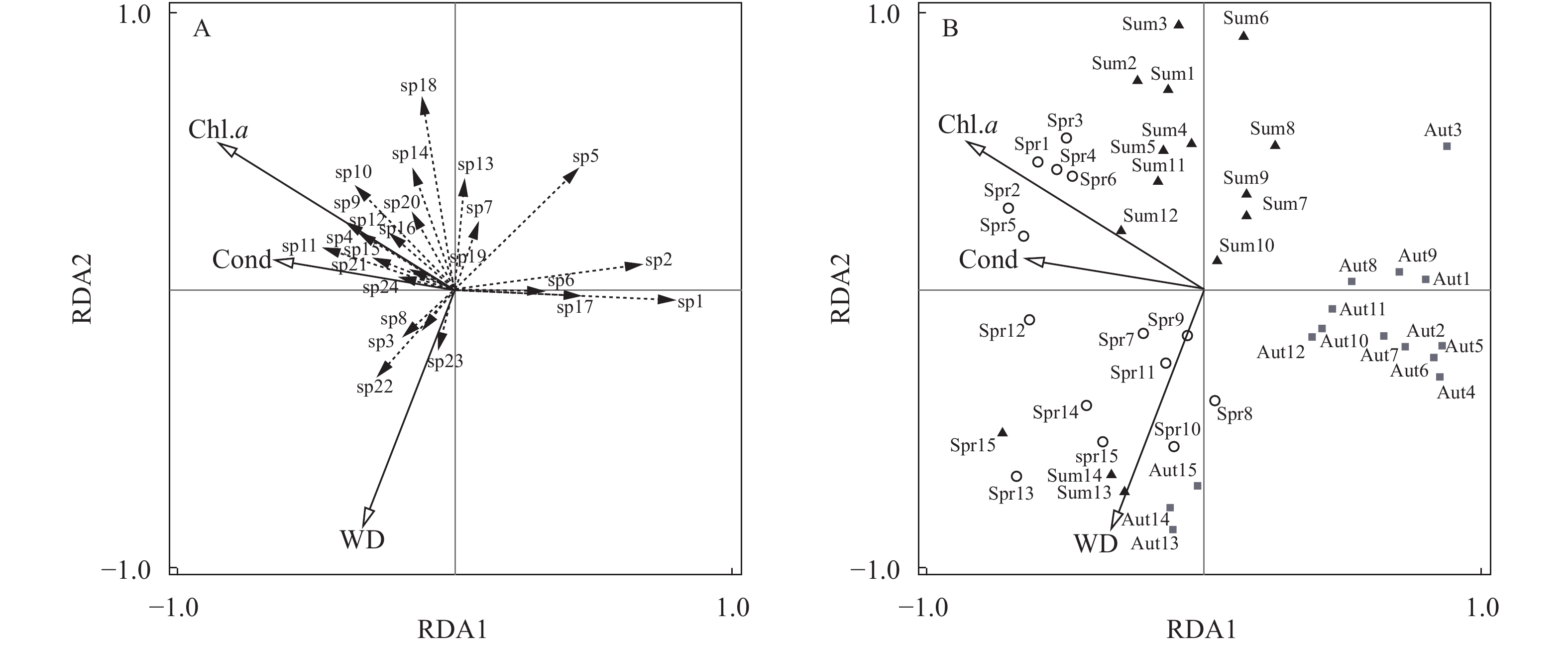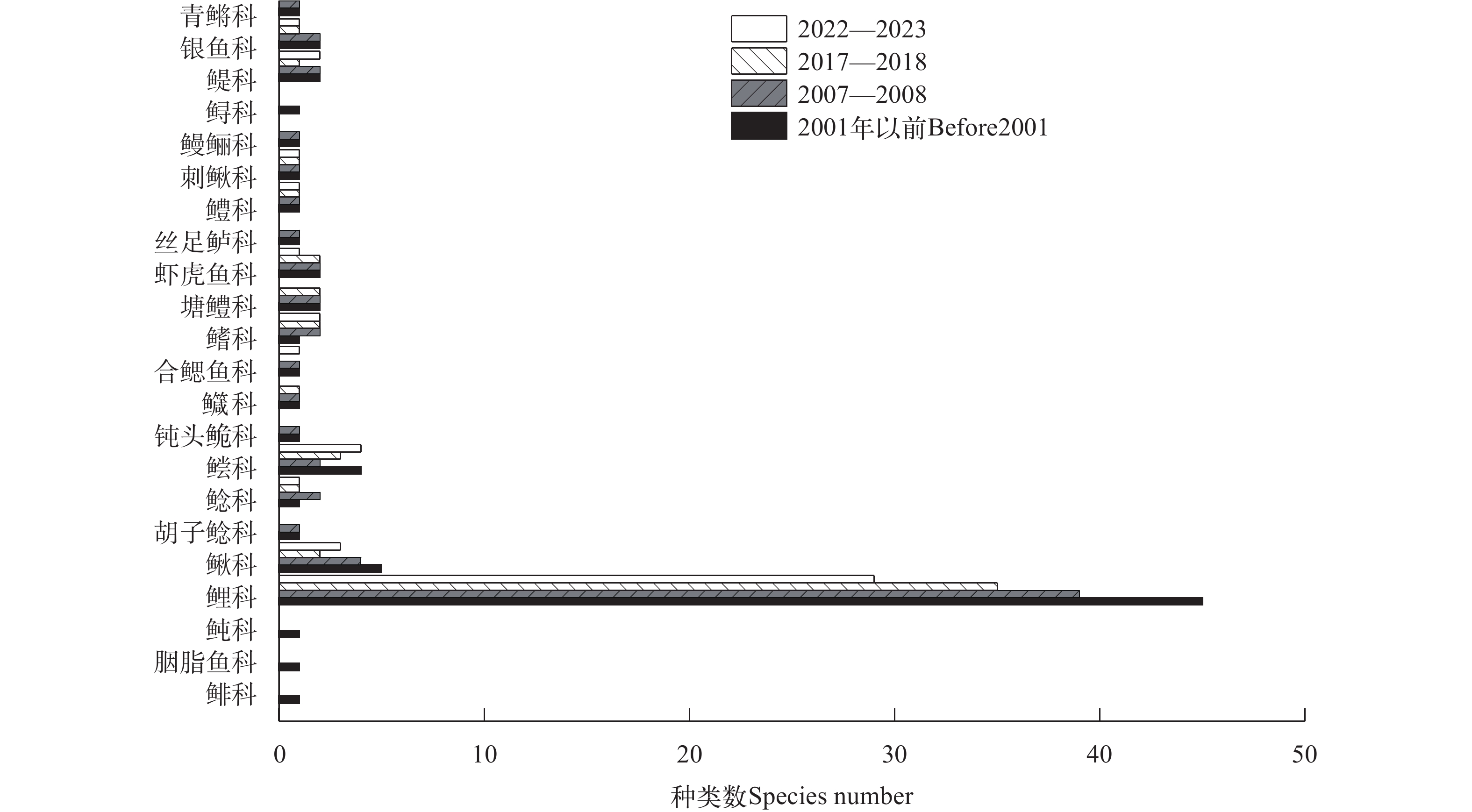CHARACTERISTICS AND HISTORICAL CHANGES OF FISH COMMUNITY IN CAIZI LAKE DURING THE EARLY PERIOD OF THE “10-YEAR FISHING BAN”
-
摘要:
为了解菜子湖禁捕初期鱼类群落特征及其历史变化, 于2022年7月(夏季)、10月(秋季)和2023年5月(春季)开展了3次调查。研究结果表明, 共采集鱼类46种, 隶属于6目11科36属, 其中鲤科鱼类占63.04%, 主要优势种包括短颌鲚(Coilia brachygnathus)、似鱎(Toxabramis swinhonis)、达氏鲌(Chanodichthys dabryi)、鲢(Hypophthalmichthys molitrix)、鳙(Aristichthys nobilis)、似鳊(Pseudobrama simoni)和鲫(Carassius auratus)等7种。按生活习性划分, 菜子湖主要以定居性鱼类为主, 占总种类数的89.13%; 空间和营养生态位方面, 主要以底栖性和杂食性鱼类为主, 分别占总种类数的39.13%和41.30%。三个不同季节之间鱼类多样性指数存在显著差异, 其中春、秋两季Shannon多样性指数、Pielou均匀度指数和Margalef丰富度指数均显著高于夏季, 但夏季Simpson优势度指数显著高于春季和秋季。NMDS和SIMPER分析结果表明, 不同季节之间鱼类群落结构存在显著差异, 任意两个季节之间虽有一定重叠, 但仍能够较好的分离, 其中短颌鲚、达氏鲌和似鱎为主要贡献种。RDA分析结果显示, 水深、电导率和叶绿素a是影响菜子湖鱼类群落结构的主要环境因子。与历史资料相比, 本次调查记录到的种类数远低于2001年前以及2007—2008年, 但与2017—2018年记录的种类数差异不大, 且鲂(Megalobrama mantschuricus)、花斑副沙鳅(Parabotia fasciata)、大鳞副泥鳅(Paramisgurnus dabryanus)和光泽黄颡鱼(Pelteobaggrus nitidus)等4种鱼类仅在本次调查中出现。总体而言, 菜子湖禁捕初期鱼类种类数并未明显上升, 仍需采取针对性措施并持续开展跟踪监测。
Abstract:Three surveys were conducted in July 2022 (summer), October 2022 (autumn), and May 2023 (spring) to understand the characteristics and historical changes of fish communities in Caizi Lake during the early period of the “10-Year Fishing Ban”. The results showed that a total of 46 fish species belonging to 6 orders, 11 families, and 36 genera, with Cyprinidae accounting for 63.04% of the total species. The main dominant species including 7 species, i.e. Coilia brachygnathus, Toxabramis swinhonis, Culter dabryi, Hypophthalmichthys molitrix, Aristichthys nobilis, Pseudobrama simoni, and Carassius auratus. According to the living habits, most species were resident fish (89.13%). In terms of spatial and nutritional niche, benthic and omnivorous fish were dominant, accounting for 39.13% and 41.30% of the total species, respectively. Significant differences in fish diversity indices were observed across the three seasons, with higher Shannon diversity index, Pielou evenness index, and Margalef richness indices in spring and autumn compared to summer. However, the Simpson dominance index in summer exceeded that in spring and autumn. NMDS and SIMPER analysis indicated that significant differences in the structure of fish communities in different seasons, with notable contributing species such as Coilia brachygnathus, Chanodichthys dabryi, and Toxabramis swinhonis. RDA analysis showed that water depth, electrical conductivity, and chlorophyll a as key environmental factors affecting the fish community structure in Caizi Lake. Compared with historical data, the species number in this survey was much lower than that before 2001 and 2007—2008, yet it exhibited minimal variance from the count in 2017—2018. Besides, four fish species, including Megalobrama mantschuricus, Parabotia fasciata, Paramisgurnus dabryanus, and Pelteobaggrus nitidus, were exclusively observed in this survey. Overall, the fish species number did not obviously increased in Caizi Lake during the early period of the “10-Year Fishing Ban”, emphasizing the necessity for targeted measures and ongoing monitoring efforts.
-
Keywords:
- Caizi Lake /
- 10-Year Fishing Ban /
- Fish community /
- Diversity /
- Historical change
-
长江中下游泛滥平原湖泊众多, 总面积达1.58×104 km2 [1]; 历史上这些湖泊均与长江干流自然连通, 形成独特的江湖复合生态系统, 孕育了复杂的淡水生物群落, 是世界上罕有的淡水物种资源库[2]。鱼类作为该生态系统的顶级类群, 在维持生态系统平衡和稳定中发挥着关键作用[3]。然而, 受建闸筑坝、水体污染、过度捕捞和围湖造田等人为干扰的影响, 长江泛滥平原生态系统结构已发生明显改变, 生态服务功能严重丧失, 渔业资源严重退化[2]。依据2017—2021年调查结果, 长江当前渔业资源量仅相当于20世纪50年代的27.3%[4], 水生生物完整性指数已经到了最差的“无鱼”等级[5]。为改变这一不利局面, 我国从2021年起全面实施长江十年禁渔。在这种背景下开展长江流域重点水域渔业资源监测, 对禁捕效果评估和针对性管理措施制定均具有重要意义。
菜子湖是长江下游重要的泛滥平原湖泊之一, 也是安徽省第二大湖泊。历史上该湖泊与长江干流自由连通, 不仅是湖泊定居性鱼类重要的繁殖场和栖息地, 还是大量江湖洄游、河流性鱼类关键的育肥场[6]。然而, 受闸坝建设、过度捕捞和围网养殖等不利因素的影响, 菜子湖鱼类多样性保护和渔业资源量维持也面临巨大挑战[6, 7]。依据历史资料记载, 菜子湖在2001年前及2007—2008年分别记录鱼类79和68种[7], 而2017—2018年仅记录到52种[8]; 渔产量也由建闸前的6540吨下降到1978—1980年的1500吨[9]。为了恢复菜子湖渔业资源, 该湖泊从2021年起开始全面实施禁渔。为了解菜子湖禁捕初期鱼类群落特征及其历史变化, 本研究于2022年7月(夏季)、10月(秋季)和2023年5月(春季)对菜子湖鱼类群落及其主要环境因子进行了系统监测, 以期为菜子湖渔业资源管理与生态调控提供科学依据。
1. 材料与方法
1.1 研究区域概况
菜子湖(30°43′—30°58′N, 117°01′—117°09′E)位于长江北岸安徽省境内, 横跨安庆市和铜陵市, 水面由白兔湖、嬉子湖和菜子湖3个湖区组成, 是长江下游典型的泛滥平原湖泊[10]。湖区属于亚热带季风气候, 年均气温和年均降水量分别为16.5℃和1325.5 mm, 平均水深1.67 m[11]。菜子湖平水期面积为172.1 km2, 主要入湖河流包括龙眠河、大沙河和挂车河等, 但出湖河流仅长河一条, 历史上菜子湖通过长河与长江干流自由连通, 1959年枞阳闸的建造使菜子湖成为江湖阻隔湖泊[9]。本研究于2022年7月(夏季)、10月(秋季)和2023年5月(春季)对菜子湖进行3次鱼类资源调查, 每次调查均设置15个采样点, 其中菜子湖主湖区12个样点, 长河中设置3个样点(图 1)。菜子湖主湖区样点均为敞水区, 无水生植物分布; 长河由于是引江济淮的输水通道, 采样点水深较深且无水生植物分布, 但沿岸带植被覆盖率较高。
1.2 调查方法
每个样点使用三层复合刺网和定置串联笼壶进行调查。复合刺网网长200 m, 网高2 m, 网目包括4种规格, 分别为2、6、10和14 cm。定置串联笼壶网长18 m, 宽45 cm, 高33 cm, 网目尺寸为0.8 cm。每个样点均放置2条三层复合刺网和3条定置串联笼壶, 放置时间均为12h。在采样结束后, 现场对所有物种进行鉴定, 然后分种类分别统计渔获物的数量和重量。
采样同时, 现场使用便携式水质分析仪(YSI ProPlus)测量采样点的水温(Temperature, T)、pH、电导率(Conductivity, Cond)和溶解氧(Dissolved oxygen, DO); 使用便携式测深仪(SM-5)测定水深(Water depth, WD); 使用萨氏盘和便携式浊度仪分别测定水体的透明度(Sechii depth, SD)和浊度(Nephelometric turbidity unit, NTU)。每个样点另取混合水样, 带回实验室依据《水和废水监测分析方法》(第四版)[12]测定水体中叶绿素a (Chlorophyll a, Chl. a)、总氮(Total nitrogen, TN)、总磷(Total phosphorus, TP)、氨氮(Ammonia nitrogen, NH4-N)和亚硝酸盐氮(Nitrite nitrogen, NO2-N)等水质指标(表 1)。考虑到饵料生物对鱼类群落可能存在较大影响, 每个样点按照标准方法采集浮游动物、浮游植物和底栖动物, 其生物量也作为环境因子参与分析。
表 1 不同季节菜子湖水体理化参数(均值±标准差)Table 1. Water physiochemical parameters of Caizi Lake in different seasons (mean±SD)指标
Index春季
Spring夏季
Summer秋季
Autumn水温T (℃ ) 24.09±1.27 29.99±0.87 21.34±3.37 pH 8.24±0.52 8.39±0.37 8.13±0.10 电导率Cond (μS/cm) 236.77±31.59 202.19±21.48 187.51±8.62 溶解氧DO (mg/L) 7.95±1.18 8.23±0.78 7.76±0.67 水深WD (m) 4.23±2.72 3.35±1.77 3.68±1.94 透明度SD (cm) 32.27±10.15 28.60±11.15 21.93±6.30 叶绿素a Chl. a (μg/L) 36.43±22.45 30.75±13.59 5.71±2.13 总氮TN (mg/L) 0.76±0.49 0.69±0.30 1.59±0.59 总磷TP (mg/L) 0.26±0.12 0.13±0.03 0.04±0.01 浊度NTU 54.48±12.13 48.85±18.36 66.60±20.37 氨氮NH4-N (mg/L) 0.25±0.07 0.37±0.25 0.32±0.13 亚硝酸盐氮NO2-N (mg/L) 0.01±0.01 0.02±0.01 0.01±0.01 1.3 数据分析
优势种 本研究运用Pinkas等[13]的相对重要性指数(Index of relative importance, IRI) 来评价鱼类群落优势种:
$$ {\rm{IRI}} = (N\text{%} + W\text{%}) \times F\text{%} $$ (1) 式中, N% 为某一种鱼类的尾数占总尾数的百分比, W%为某一种鱼类的重量占总重量的百分比, F%为某一种鱼类出现的次数占总调查次数的百分比。本研究中, 将IRI≥1000的物种定义为优势种。
生态类型 依据生活习性将菜子湖鱼类分为定居性、河流性、江湖洄游性和河海洄游性鱼类[14]; 按空间生态位可分为中上层、中下层和底栖性鱼类; 按营养生态位可分为肉食性、植食性、浮游生物食性和杂食性鱼类[15, 16]。此外, 本研究将初次性成熟小于2龄, 最大体长小于24 cm的鱼类定义为小型鱼类[17]。
鱼类群落多样性 本研究用Margalef丰富度指数(R)、Shannon多样性指数(H)、Simpson优势度指数(D)和Pielou均匀度指数(E)对菜子湖鱼类群落多样性进行评价, 公式如下:
$$ R = (S – 1) / lnN \;\;\; $$ (2) $$ H = - \sum\limits_{i = 1}^{\text{s}} {{P_i}\ln {P_i}} $$ (3) $$ D = 1 - {\sum\limits_{i = 1}^s {{P_i}} ^2} \;\;\;$$ (4) $$ E = H / {\rm{ln}}S \qquad \;\;\;$$ (5) 式中, S为样品中的总种类数, N为样品中物种个体的总数; Pi为群落中第i物种的个体数占所有物种个体数的比例[18]。
采用单因素方差分析(One-way ANOVA)检验不同季节四个多样性指数之间的差异。若有显著差异, 采用Duncan’s多重比较来检验组之间的差异。
群落结构 采用Jaccard相似性指数(JSI)对采集的鱼类群落进行相似性分析[19]。其计算公式为:
$$ {\rm{JSI}} = c/(a+b–c) $$ (6) 式中, a和b为A、B两次调查采集鱼类的种类数; c是A、B两次采集的共有鱼类种类数, 当JSI的值在0—0.25时, 为极不相似; 在0.25—0.50时, 为中等不相似; 在0.50—0.75时, 为中等相似; 在0.75—1.00时, 为极相似[20]。
利用Primer 5.0软件对鱼类群落结构进行统计分析, 将不同季节鱼类数量组成作为原始矩阵, 进行 log2(X+1)转换后, 计算Bray-Crutis相似性系数矩阵, 再运用非线性多维标度排序(Nonmetric multidimensional scaling, NMDS) 对不同季节的鱼类群落结构进行分析, 并利用单因素相似性分析(ANOSIM)检验各类群结构间的差异性。用胁迫系数(Stress)衡量NMDS二维点图的优劣, stress<0.1时, 表明排序较好; 0.1<stress<0.2时, 表示具有一定解释意义; stress>0.2 时, 表明排序无解释意义[21]。根据R值确定鱼类群落的分离程度: R>0.75, 群落完全分离; 0.5<R<0.75, 群落少量重叠但仍明显分离; 0.25<R<0.5, 群落存在一定重叠但仍然可分; R<0.25, 群落明显重叠几乎不可分[22]。运用相似性百分比分析(Similarity percentages, SIMPER)确定维持不同季节内鱼类群落结构相似性的重要物种。
采用Canoco 5.0软件对渔获物数量和环境因子进行梯度分析, 首先对渔获物数量进行除趋势对应分析(Detrended correspondence analysis, DCA), 根据分析结果中各排序轴长度判断采用线性或非线性模型(gradient length>4, 为非线性; 3<gradient length<4, 线性和非线性均可; gradient length<3, 则为线性)[23], 本研究的排序轴长为2.0, 因此选择了冗余分析(Redundancy analysis, RDA)。在进行RDA分析前, 为了降低极端数据造成的负面影响, 并提高数据的正态性和方差齐性, 首先将渔获物数量百分比低于0.1%的种类去除, 然后对渔获物数量与环境因子数据均进行log2(X+1) 转化[24]。本研究中12个水体理化因子以及3种饵料生物(浮游动物、浮游植物和底栖动物)的生物量作为环境因子参与RDA分析。分析前使用Spearman相关来检验15个环境因子之间的相关性, 排除高度相关(|r| >0.7)的两个环境因子中重要性较低的一个[25], 因此最后实际只有13个环境因子参与分析。
历史变化 菜子湖在2001年前、2007—2008及2017—2018年鱼类历史数据用于鱼类群落历史变化的对比分析, 数据来源于已发表文献[7, 8]。数据分析前, 对历史数据中鱼类的同物异名和拉丁名分别进行校核, 以提高数据的可靠性。校核后菜子湖在2001年前以及2007—2008年实际分别记录鱼类77和66种。
2. 结果
2.1 种类组成
共鉴定出鱼类46种, 隶属于6目11科36属, 其中鲤形目鱼类最多, 为32种, 占总物种数的69.57%; 其次是鲇形目, 为5种, 占总物种数的10.87%; 鲈形目4种, 占总物种数的8.70%; 鲱形目和合鳃鱼目均为2种, 各占总物种数的4.35%; 鲑形目1种, 占总物种数的2.17%。春、夏和秋季分别采集鱼类40、35和33种, 其中刀鲚(Coilia ectenes)、黄鳝(Monopterus albus)、鲂(Megalobrama mantschuricus)、花斑副沙鳅(Parabotia fasciata)和棒花鱼(Abbottina rivularis)仅在春季调查发现; 草鱼(Ctenopharyngodon idellus)和飘鱼(Pseudolaubuca sinensis)仅在秋季调查发现; 鳡(Elopichthys bambusa)、中华刺鳅(Sinobdella sinensis)和大鳞副泥鳅(Paramisgurnus dabryanus)仅在夏季调查中发现。
2.2 优势种
春、夏、秋三季菜子湖鱼类共出现优势种7种, 分别是短颌鲚(Coilia brachygnathus)、似鱎(Toxabramis swinhonis)、达氏鲌(Chanodichthys dabryi)、鲢(Hypophthalmichthys molitrix)、鳙(Aristichthys nobilis)、似鳊(Pseudobrama simoni)和鲫(Carassius auratus), 7种优势种的总数量和总重量分别占渔获物总量的81.86%和81.84%。不同季节菜子湖鱼类优势种变化较小, 夏季和秋季均为5种, 春季为7种, 且三个季节短颌鲚均为第一优势种(表 2)。
表 2 不同季节菜子湖鱼类优势种组成Table 2. Composition of the dominant fish species in different seasons in Caizi Lake种类Species 春季Spring 夏季Summer 秋季Autumn N% W% F% IRI N% W% F% IRI N% W% F% IRI 短颌鲚 27.45 2.44 93.3 2790 32.98 5.60 100.0 3858 56.51 8.06 100.0 6457 似鱎 15.20 1.11 93.3 1522 17.61 1.19 100.0 1880 27.09 3.53 86.7 2653 达氏鲌 7.83 3.64 100.0 1147 21.61 2.79 100.0 2440 9.76 3.50 100.0 1326 鲢 0.70 19.59 73.3 1488 1.02 21.90 93.3 2139 0.89 45.44 100.0 4633 鳙 0.74 36.52 60.0 2235 1.13 47.95 100.0 4907 0.20 22.55 80.0 1820 似鳊 11.18 1.17 93.3 1152 — — — — — — — — 鲫 10.07 9.98 100.0 2004 — — — — — — — — 注: “—”表示该季节优势种未出现; N%表示数量百分比; W%表示重量百分比; F%表示出现频率百分比; IRI表示相对重要指数Note: “—” indicates the species do not appear during the season; N% represents the percentage of quantity; W% represents the percentage of weight; F% represents the percentage of occurrence frequency; IRI represents the index of relative importance 2.3 生态类型
菜子湖不同生态类型鱼类种类数、数量和重量均存在较大差异(图 2)。生活习性方面, 定居性鱼类种类数和数量均占优势地位, 分别占渔获物总量的89.13%和98.51%; 江湖洄游性鱼类重量占优势地位, 占渔获物总量的65.42%。空间生态位方面, 底栖性鱼类种类数占优势地位, 占总种类数的39.13%; 中上层鱼类的数量和重量均占优势地位, 分别占渔获物总量的79.95%和86.54%。营养生态位方面, 杂食性鱼类种类数占优势地位, 占总种类数的41.30%; 肉食性鱼类的数量占优势地位, 占渔获物总量的62.06%; 浮游生物食性鱼类重量占优势地位, 占渔获物总量的68.02%。鱼类个体大小方面, 菜子湖共采集小型鱼类25种, 其种类数和数量分别占渔获物总量的54.35%和77.63%, 但重量仅占渔获物总量的10.80%(图 2)。
2.4 鱼类多样性
对菜子湖三个季节所有渔获物进行合并分析, 结果表明鱼类的Shannon 多样性指数(H)、Pielou 均匀度指数(E)、Simpson 优势度指数(D)和Margalef丰富度指数(R)分别为1.99、0.52、0.26和4.28。不同季节, 4个多样性指数之间均存在显著差异; 春、秋季H、E和R指数均显著高于夏季; 夏季D指数显著高于春、秋季(图 3)。
2.5 群落结构
NMDS分析结果表明, 3个季节鱼类群落的Stress为0.14, 表明鱼类群落结构分析具有解释意义(图 4)。单因素相似性分析(ANOSIM)结果表明, 不同季节之间鱼类群落结构存在显著差异(R=0.41, P<0.01); 任意2个季节之间虽有一定重叠, 但仍能够较好的分离(春、夏季R=0.28, P<0.01; 夏、秋季R=0.40, P<0.01; 春、秋季R=0.52, P<0.01)。
SIMPER分析结果表明, 维持春、夏和秋季鱼类群落内相似性的重要贡献物种分别为15、15和11种(表 3)。3个季节重复出现且平均多度和贡献率较高的物种为达氏鲌、短颌鲚和似鱎; 细鳞鲴(Xenocypris microlepis)、银(Squalidus argentatus)和蛇(Saurogobio dabryi)等仅是春季的重要物种; 花䱻(Hemibarbus maculatus)和子陵吻虾虎鱼(Rhinogobius giurinus)仅是夏季的重要物种。
表 3 维持不同季节鱼类群落结构相似性的重要物种和贡献率Table 3. Important species in different seasons and their contributions to the similarity of fish communities based on SIMPER物种
Species平均多度/平均相似性
Average abundance/Average similarity (%)贡献率/累积贡献率
Contribution/Cumulative contribution (%)春季Spring 夏季Summer 秋季Autumn 春季Spring 夏季Summer 秋季Autumn 达氏鲌 31.93/6.99 136.93/9.63 139.27/11.93 10.74/10.74 13.87/13.87 16.77/16.77 鲫 41.07/6.75 28.33/5.95 15.13/4.48 10.37/21.11 8.57/22.44 6.29/23.06 似鱎 62.00/6.21 111.6/7.21 386.47/9.84 9.53/30.64 10.39/32.83 13.82/36.88 短颌鲚 112.00/5.51 208.93/9.20 806.20 /16.77 8.47/39.11 13.24/46.07 23.57/60.45 似鳊 45.60/5.5 29.00/3.68 4.00/1.96 8.45/47.57 5.29/51.36 2.75/63.15 黄颡鱼 9.67/4.98 10.40/2.52 — 7.64/55.21 3.63/54.99 — 似刺鳊 8.07/3.82 21.47/4.14 — 5.87/61.08 5.97/60.96 — 细鳞鲴 17.60/3.30 — — 5.07/66.15 — — 翘嘴鲌 6.60/3.23 6.60/3.41 2.47/1.66 4.96/71.11 4.91/65.87 2.33/65.48 蒙古鲌 15.07/3.05 — 32.6/5.26 4.69/75.80 — 7.40/72.88 鲤 5.67/2.62 3.00/2.33 4.07/2.94 4.02/79.82 3.35/69.22 4.13/77.01 大鳍鱊 8.47/2.42 6.67/1.37 — 3.71/83.53 1.97/71.19 — 团头鲂 3.20/1.70 5.93/2.75 4.33/2.45 2.62/86.15 3.96/75.15 3.44/80.45 银 6.60/1.53 — — 2.35/88.50 — — 蛇 12.60/1.49 — — 2.28/90.79 — — 鳙 — 7.13/3.25 2.87/2.15 — 4.68/79.83 3.02/83.47 鲢 — 6.47/2.97 12.67/5.88 — 4.27/84.10 8.27/91.74 花䱻 — 6.87/2.88 — — 4.14/88.24 — 子陵吻虾虎鱼 — 5.87/1.71 — — 2.40/90.64 — 注: 根据相关性分析, 依次列出累积贡献率达到90%的重要物种Note: According to the correlation analysis, the important species with a cumulative contribution rate of 90% are listed in order RDA排序前两轴的特征值分别为0.56和0.01, 分别解释了55.74%和1.29%的物种-环境变量。蒙特卡洛(Monte-Carlo)检验分析表明, 排序轴的特征值具有显著性(P<0.05)。13个环境因子当中, WD、Cond和Chl. a为影响鱼类空间分布的主要环境因子, 其中Cond和Chl. a主要贡献于第一排序轴, WD主要贡献于第二排序轴(图 5)。
![]() 图 5 鱼类群落(A)和采样点(B)与环境因子的冗余分析sp1. 短颌鲚; sp2. 似鱎; sp3. 贝氏䱗; sp4. 翘嘴鲌; sp5. 达氏鲌; sp6. 蒙古鲌; sp7. 红鳍原鲌; sp8. 团头鲂; sp9. 细鳞鲴; sp10. 似鳊; sp11. 大鳍鱊; sp12. 兴凯鱊; sp13. 花䱻; sp14. 似刺鳊; sp15. 银; sp16. 蛇; sp17. 鲢; sp18. 鳙; sp19. 鲤; sp20. 鲫; sp21. 黄颡鱼; sp22. 光泽黄颡鱼; sp23. 鳜; sp24. 子陵吻虾虎鱼; Spr1—15. 春季样点1—15; Sum1—15. 夏季样点1—15; Aut1—15. 秋季样点1—15; Chl. a. 叶绿素a; Cond. 电导率; WD. 水深Figure 5. Redundancy analyses of fish community (A) and sampling sites (B) with environmental factorssp1. Coilia brachygnathus; sp2. Toxabramis swinhonis; sp3. Hemiculter bleekeri; sp4. Culter alburnus; sp5. Chanodichthys dabryi; sp6. Chanodichthys mongolicus; sp7. Cultrichthys erythropterus; sp8. Megalobrama amblycephala; sp9. Xenocypris microlepis; sp10. Pseudobrama simoni; sp11. Acheilognathus macropterus; sp12. Acheilognathus chankaensis; sp13. Hemibarbus maculatus; sp14. Paracanthobrama guichenoti; sp15. Squalidus argentatus; sp16. Saurogobio dabryi; sp17. Hypophthalmichthys molitrix; sp18. Aristichthys nobilis; sp19. Cyprinus carpio; sp20. Carassius auratus; sp21. Pelteobagrus fulvidraco; sp22. Pelteobaggrus nitidus; sp23. Siniperca chuatsi; sp24. Rhinogobius giurinus; Spr1—15. Spring samples 1—15; Sum1—15. summer samples 1—15; Aut1—15. Autumn samples 1—15; Chl. a. Chlorophyll a; Cond. Conductivity; WD. water depth
图 5 鱼类群落(A)和采样点(B)与环境因子的冗余分析sp1. 短颌鲚; sp2. 似鱎; sp3. 贝氏䱗; sp4. 翘嘴鲌; sp5. 达氏鲌; sp6. 蒙古鲌; sp7. 红鳍原鲌; sp8. 团头鲂; sp9. 细鳞鲴; sp10. 似鳊; sp11. 大鳍鱊; sp12. 兴凯鱊; sp13. 花䱻; sp14. 似刺鳊; sp15. 银; sp16. 蛇; sp17. 鲢; sp18. 鳙; sp19. 鲤; sp20. 鲫; sp21. 黄颡鱼; sp22. 光泽黄颡鱼; sp23. 鳜; sp24. 子陵吻虾虎鱼; Spr1—15. 春季样点1—15; Sum1—15. 夏季样点1—15; Aut1—15. 秋季样点1—15; Chl. a. 叶绿素a; Cond. 电导率; WD. 水深Figure 5. Redundancy analyses of fish community (A) and sampling sites (B) with environmental factorssp1. Coilia brachygnathus; sp2. Toxabramis swinhonis; sp3. Hemiculter bleekeri; sp4. Culter alburnus; sp5. Chanodichthys dabryi; sp6. Chanodichthys mongolicus; sp7. Cultrichthys erythropterus; sp8. Megalobrama amblycephala; sp9. Xenocypris microlepis; sp10. Pseudobrama simoni; sp11. Acheilognathus macropterus; sp12. Acheilognathus chankaensis; sp13. Hemibarbus maculatus; sp14. Paracanthobrama guichenoti; sp15. Squalidus argentatus; sp16. Saurogobio dabryi; sp17. Hypophthalmichthys molitrix; sp18. Aristichthys nobilis; sp19. Cyprinus carpio; sp20. Carassius auratus; sp21. Pelteobagrus fulvidraco; sp22. Pelteobaggrus nitidus; sp23. Siniperca chuatsi; sp24. Rhinogobius giurinus; Spr1—15. Spring samples 1—15; Sum1—15. summer samples 1—15; Aut1—15. Autumn samples 1—15; Chl. a. Chlorophyll a; Cond. Conductivity; WD. water depth2.6 鱼类历史变化
本次调查共记录鱼类46种, 远低于2001年前及2007—2008年调查分别记录到的77和66种, 但与2017—2018年调查记录的52种差异不大。与历史数据相比, 鲤科鱼类种类数明显减少, 且历史上有记录的鲱科、鲟科、胭脂鱼科、鳗鲡科、鲀科、钝头鮠科、丝足鲈科、塘鳢科、鱵科和异鳉科等在本次调查中均未出现(图 6), 但鲂(Megalobrama mantschuricus)、花斑副沙鳅(Parabotia fasciata)、大鳞副泥鳅(Paramisgurnus dabryanus)和光泽黄颡鱼(Pelteobaggrus nitidus)等4种鱼类仅出现在本次调查。生态类型方面, 与2001年前历史数据相比, 中上层、中下层和底栖性鱼类分别由30、22和25种减少到17、11和18种; 定居性、江湖洄游性和河海洄游性鱼类分别由63、8和5种减少到41、4和1种; 杂食性和肉食性鱼类分别由33和27种减少到19和15种。Jaccard相似性指数分析结果表明, 本此调查与2007—2008年调查共有鱼类37种, 物种相似指数为0.49, 为中等不相似; 与2017—2018年共有鱼类34种, 物种相似性指数为0.53, 为中等相似。
3. 讨论
3.1 种类组成
菜子湖不仅是长江下游重要的泛滥平原湖泊, 还是引江济淮工程重要的输水通道[26], 其生态健康直接关乎区域生物多样性的维持和经济社会的可持续发展。鱼类作为湖泊生态系统的重要组成部分, 不仅可通过营养级联效应调控其他水生生物群落, 还对水环境质量有重要影响[27, 28], 因此对菜子湖鱼类多样性和群落结构的研究对湖泊的生态管理有重要意义。本研究结果表明, 菜子湖共记录鱼类46种, 略低于同一区域通江湖泊七里湖的47种[29], 以及巢湖最新记录的52种[3]。与历史数据相比, 也远低于2001年前及2007—2008年调查分别记录到的77和66种 [7]。历史上曾有分布的一些珍稀濒危和洄游性物种如中华鲟(Acipenser sinensis)、胭脂鱼(Myxocyprinus asiaticus)、鲥(Tenualosa reevesii)、日本鳗鲡(Anguilla japonica)、鯮(Luciobrama macrocephalus)和鳤(Ochetobius elongatus)等本次调查均未发现。20世纪50—60年代曾有较高产量的洄游性鱼类—刀鲚[7], 本次调查也仅在长河有零星发现。前期研究认为, 江湖阻隔及湖泊渔业管理模式的变化是导致菜子湖出现以上结果的主要原因[7, 8]。江湖阻隔直接切断了鱼类的洄游通道, 导致湖泊鱼类得不到江河鱼类的有效补充[8, 14]; 而湖泊渔业管理模式的变化(由捕捞渔业变为养殖渔业)则直接压缩了相同食性其他鱼类的生存空间, 导致鱼类区系组成单一化、物种多样性进一步降低[7]。菜子湖建闸后逐渐由传统的捕捞渔业向养殖渔业转变, 至2005年湖区围网养殖面积已占水体总面积的90%以上, 这一严重的人为干扰对菜子湖鱼类群落的结构和功能完整性产生了明显的不利影响[7]。除此之外, 过度捕捞和围湖造田等也被认为是菜子湖物种多样性降低不可忽视的重要因素[30]。
与2017—2018年调查结果相比, 虽然二者种类数相差不大, 但物种组成的相似度不高。例如在2017—2018年记录到的马口鱼(Opsariichthys bidens)、高体鳑鲏(Rhodeus ocellatus)、银(Squalidus argentatus)和小黄䱂(Micropercops swinhonis)等常见小型鱼类本次调查并未发现。这可能主要是由于调查样点的数量和位置造成的, 其次渔具的不同也有重要影响。不同渔具对捕获对象都具有一定的选择性[31], 且小型鱼类一般更喜欢沿岸带水草丰富且有避敌场所的栖息生境[32-34]。本次调查样点设置更偏重于敞水区域, 且所用刺网和地笼对小型鱼类的捕获效率可能明显低于2017—2018年所使用的网簖, 因此小型鱼类种类数偏少。此外, 渔具的不同可能也是本次调查种类数明显低于2007—2008年调查结果的重要因素之一, 王晨旭等[7]研究中所采用的电网、迷魂阵、地笼、刺网和赶网等更多样的捕捞方式, 明显更利于捕获更多的种类。值得注意的是, 本次调查还新发现鲂、花斑副沙鳅、大鳞副泥鳅和光泽黄颡鱼等4种鱼类。除鲂为较大型的经济鱼类, 其他3种均为长江中下游流域常见小型鱼类。历史调查均未记录可能主要跟捕捞的努力强度有关。
3.2 群落结构
本研究中鲤形目鱼类最多, 占总物种数的69.57%; 与巢湖的63.46%[3]和太湖的60.00%[35]较为接近。优势种组成方面, 本研究中3个季节优势种较为相似, 均包括鲢、鳙、短颌鲚、似鱎和达氏鲌等5种鱼类, 这与安徽省内同为阻隔湖泊的巢湖较为相似[3], 但与通江湖泊七里湖差异较大[29]。黄颡鱼(Pelteobagrus fulvidraco)、大鳍鱊(Acheilognathus macropterus)、贝氏䱗(Hemiculter bleekeri)和蛇(Saurogobio dabryi)等均为通江湖泊七里湖的优势种, 但在菜子湖中优势度均极低。这种现象的产生可能是水文因素与过度捕捞共同作用的结果。通江湖泊特殊的水文节律提高了生境的异质性, 可能为小型鱼类提供更为多样的栖息生境; 而过度捕捞则直接导致大型鱼类和凶猛性鱼类的减少, 减轻了对小型鱼类的捕食压力[31, 36]。对通江湖泊鄱阳湖的研究也有类似的结果, 黄颡鱼、贝氏䱗和蛇等均是主要优势种[25]。在生态类型方面, 大部分洄游性鱼类已基本上消失, 本次调查仅发现刀鲚、鳡、鲢、鳙和草鱼(Ctenopharyngodon idellus)等5种。菜子湖近几十年一直采取增殖放流的措施, 因此推测绝大多数鲢、鳙和草鱼均为人工增殖放流的种类; 刀鲚和鳡则可能是通过江水倒灌或汛期排水由枞阳闸进入菜子湖的自然补充群体。枞阳闸的建立虽然阻断了菜子湖与长江干流的自然连通, 但闸门每年仍保持一定时间的开启[8], 这为极少量洄游物种进入菜子湖打开了机会窗。空间分布和食性上, 菜子湖分别以底栖性和杂食性鱼类种类数最多, 这与长江干流安庆段的调查结果有较高的一致性[37]。
与2007—2008年历史数据相比, 由于湖泊渔业管理模式的变化以及禁捕政策的双重影响, 两个时期鱼类群落结构也出现了明显变化, 具体表现在以下几个方面: (1)两个时期虽然渔获物重量均以中上层和浮游生物食性鱼类最高, 但主要优势种鲢、鳙等的渔产量占比已由2007—2008年大规模围网养殖时期的约90%[7, 30]降低至禁捕后的60.86%; (2)在禁捕后人为威胁因素的消失以及丰富的饵料来源, 导致短颌鲚和达氏鲌等肉食性鱼类的数量和重量明显上升, 本研究中其渔获物数量占比甚至高达62.06%; (3)禁捕后优势种的组成明显更为多样, 由2007—2008年大规模围网养殖时期单纯以浮游生物食性鱼类为主, 演变为现阶段浮游生物食性、肉食性和杂食性鱼类均存在优势种。因此可以看出禁捕后菜子湖鱼类群落结构明显得到优化。此外, 本研究中小型鱼类种类数占比为54.35%, 这与2007—2008年调查结果的56.06%[7]极为接近, 说明近十几年来小型鱼类种类数占比保持相对稳定。
NMDS排序和ANOSIM分析结果表明, 3个不同季节鱼类物种组成结构虽有重叠, 但仍能够较好的分离, 且不同季节之间鱼类群落结构存在显著差异。3个季节由于达氏鲌、短颌鲚、似鱎、鲢和鳙等鱼类均为主要优势种, 且对群落相似性的贡献较高, 这是造成群落结构重叠的主要原因。同时, 银、蛇、花䱻和子陵吻虾虎鱼等小型鱼类对不同季节群落结构的差异性贡献较大, 是引起群落结构差异的主要物种。关于鱼类群落结构的影响因素, 目前国内外已有较多研究; 可以认为某一特定水域所呈现的鱼类群落是内部调节和外部环境因子共同作用的结果[3]。不同食性鱼类之间的捕食与被捕食关系、鱼类对栖息地的选择以及鱼类个体的时空迁移都对群落结构有显著影响[38, 39]。此外, 人为捕捞、水文节律改变和饵料生物的时空变化也对鱼类群落结构有重要的塑造作用[3, 40, 41]。就本研究而言, 13个所选变量中水深、Cond和Chl. a为影响鱼类空间分布最主要的环境因子。水深作为水文情势重要的组成成分之一, 可直接反映3个季节水位的高低变化。其他对长江泛滥平原湖泊的研究结果已表明, 水位的季节性波动是影响鱼类群落结构的主要环境因子之一[29, 42, 43]。Chl. a可直接反映浮游植物的丰富度状况, 本研究中也是影响鱼类群落的主要环境因子之一, 且与浮游生物性鱼类(如鳙和似鳊等)的分布表现出较强的相关性。国内对白洋淀以及其他长江泛滥平原湖泊的研究也有类似的结论[44, 45]。Cond由于与Chl. a等环境因子存在较高的正相关性, 因此本研究中也是主要的影响因子之一。
3.3 管理建议
总体而言, 本研究结果表明, 菜子湖禁捕初期鱼类物种多样性并未明显上升。Wang等[46]对长江干流近70年渔业资源退化过程的研究已表明, 江湖阻隔和围湖造田所引起的生境破碎化是导致长江干流鱼类多样性丧失和渔产量下降的首要因素, 过度捕捞则进一步加剧了鱼类资源的衰减。相同的是, Feng等[47]对梁子湖禁捕前后鱼类群落的研究结果也表明, 禁渔后鱼类物种丰富度、功能丰富度、分类多样性和功能多样性并未出现恢复趋势, 且持续维持在较低水平。此外, 对长江故道天鹅洲和何王庙的研究结果还表明, 禁渔后虽然鱼类生物量呈现明显增长, 但并未对湖泊生态系统的结构和物种多样性恢复产生促进作用, 反而因人工放养的大量鲢、鳙等成鱼被阻隔后导致食物网简化和多样性降低的风险增加[48]。通过以上研究似乎可以看出, 仅通过“十年禁渔”可能对恢复长江泛滥平原阻隔湖泊鱼类物种多样性帮助不大, 而恢复阻隔湖泊的自然水文连通, 打通鱼类洄游的通道可能会起到更明显的促进效果。
然而, 我们也应该注意到鱼类群落的恢复一般需要较长时间, 全长江流域从2021年起才开始全面实施十年禁渔, 禁渔效果有待通过更长期的监测进行验证。此外, 从全流域的角度来看, 全面实施十年禁渔对鱼类多样性的保护和恢复也具有重要意义; 如果贸然恢复生产性捕捞, 必然会使鱼类多样性的恢复雪上加霜, 已有禁渔成效功亏一篑。考虑到闸坝对防洪、工农业生产以及流域水资源管理的重要性, 短期内实现大量阻隔湖泊闸门的长期开放并不现实, 但在洄游性鱼类索饵、繁殖和越冬的关键时间节点分批次选择一些闸门保持开放则存在一定的可行性。此外, 除加强持续跟踪监测外, 采取其他更有针对性的措施(如多样化的生境修复、科学的增殖放流及人工放养群体的适时捕捞等)也是非常有必要的。
(作者声明本文符合出版伦理要求)
附表 1 菜子湖鱼类物种组成及历史变化Appendix 1. Composition and historical changes of fish species in Caizi Lake物种
Species生态类型
Ecological type2001年前
Before 20012007—2008 2017—2018 2022—2023 鲟形目Acipenseriformes 鲟科Acipenseridae 中华鲟Acipenser sinensis L O RS + 鲱形目Clupeiformes 鲱科Clupeidae 鲥Tenualosa reevesii U P RS + 鳀科Engraulidae 短颌鲚Coilia brachygnathus* U C SF + + + + 刀鲚Coilia ectenes* U C RS + + + 鲑形目Salmoniformes 银鱼科 Salangidae 陈氏新银鱼Neosalanx tangkahkeii* U P SF + + + + 寡齿新银鱼Neosalanx oligodontis* U P SF + 短吻间银鱼Hemisalanx brachyrostris* U P SF + 鳗鲡目Anguilliformes 鳗鲡科Anguillidae 日本鳗鲡Anguilla japonica D C RS + + 鲤形目Cypriniformes 胭脂鱼科Catostomidae 胭脂鱼Myxocyprinus asiaticus L O RL + 鲤科Cyprinidae 中华细鲫Aphyocypris chinensis* U O SF + + 马口鱼Opsariichthys bidens* U C RF + + + 宽鳍鱲Zacco platypus* U O RF + + 草鱼Ctenopharyngodon idellus L H RL + + + + 鳡Elopichthys bambusa U C RL + + + 鯮Luciobrama macrocephalus L C RL + 青鱼Mylopharyngodon piceus L C RL + + + 鳤Ochetobius elongatus U C RL + 赤眼鳟Squaliobarbus curriculus U O SF + + 达氏鲌Chanodichthys dabryi U C SF + + + + 蒙古鲌Chanodichthys mongolicus U C SF + + + + 翘嘴鲌Culter alburnus U C SF + + + + 尖头鲌Culter oxycephalus L C SF + + + 拟尖头鲌Culter oxycephaloides L C SF + 红鳍原鲌Cultrichthys erythropterus U C SF + + + + 贝氏䱗Hemiculter bleekeri* U P SF + + + + 䱗Hemiculter leucisculus* U P SF + + + + 团头鲂Megalobrama amblycephala L H SF + + + + 鲂Megalobrama mantschuricus L O SF + 鳊Parabramis pekinensis L H SF + + + + 飘鱼Pseudolaubuca sinensis* U O SF + + + 似鱎Toxabramis swinhonis* U P SF + + + + 似鳊Pseudobrama simoni* L P SF + + + + 银鲴Xenocypris argentea L H SF + + + + 细鳞鲴Xenocypris microlepis L H SF + + + 黄尾鲴Xenocypris davidi L H SF + + 湖北圆吻鲴Xenocypris hupeinensis L H SF + + 鳙Aristichthys nobilis U P RL + + + + 鲢Hypophthalmichthys molitrix U P RL + + + + 棒花鱼Abbottina rivularis* D O SF + + + + 花䱻Hemibarbus maculatus* L C SF + + + + 似刺鳊Paracanthobrama guichenoti* D O SF + + + + 麦穗鱼Pseudorasbora parva* U O SF + + + + 吻Rhinogobio typus* D O RF + + + 黑鳍鳈Sarcocheilichthys nigripinnis* D O SF + + + + 华鳈Sarcocheilichthys sinensis* L C SF + + + 蛇Saurogobio dabryi* L O SF + + + + 光唇蛇Saurogobio gymnocheilus* L O SF + + + 银Squalidus argentatus* L O SF + + + 兴凯鱊Acheilognathus chankaensis* U O SF + + + 无须鱊Acheilognathus gracilis* U O SF + 大鳍鱊Acheilognathus macropterus* U O SF + + + 越南鱊Acheilognathus tonkinensis* U O SF + 彩副鱊Paracheilognathus imberbis* U O SF + 方氏鳑鲏Rhodeus fangi* U O SF + 高体鳑鲏Rhodeus ocellatus* U O SF + + + 中华鳑鲏Rhodeus sinensis* U O SF + + + 鲫Carassius auratus L O SF + + + + 鲤Cyprinus carpio D O SF + + + + 鳅科Cobitidae 紫薄鳅Leptobotia taeniops* D C SF + + 武昌副沙鳅Parabotia banarescui* D O SF + 花斑副沙鳅Parabotia fasciata* D O SF + 大斑花鳅Cobitis macrostigma* D O SF + + + 中华花鳅Cobitis sinensis* D O SF + + 泥鳅Misgurnus anguilicaudatus* D O SF + + + + 大鳞副泥鳅Paramisgurnus dabryanus* D O SF + 鲇形目Siluriformes 鲇科Siluridae 鲇Silurus asotus D C SF + + + + 大口鲇Silurus meriordinalis D C SF + 鲿科Bagridae 黄颡鱼Pelteobagrus fulvidraco* D O SF + + + + 瓦氏黄颡鱼Pelteobagrus vachelli D O SF + + + 光泽黄颡鱼Pelteobaggrus nitidus* D O SF + 长须黄颡鱼Pelteobagrus eupogon* D O SF + + 粗唇拟鲿Pseudobagrus crassilabris* D O SF + 细体拟鲿Pseudobagrus pratti* D O SF + 大鳍鱯Mystus macropterus D O SF + 胡子鲇科Clariidae 胡子鲇Clarias fuscus D C SF + + 钝头鮠科Amblycipitidae 黑尾䱀Liobagrus nigricauda D C SF + + 鳉形目Cyprinodontiformes 青鳉科Adrianichthyidae 青鳉Oryzias latipes* U O SF + + 颌针鱼目Beloniformes 鱵科Hemirhamphidae 间下鱵Hyporhamphus intermedius* U P SF + + + 合鳃鱼目Synbranchiformes 合鳃鱼科Synbranchidae 黄鳝Monopterus albus D C SF + + + 刺鳅科Mastacembelidae 中华刺鳅Mastacembelus sinensis* D C SF + + + + 鲈形目Perciformes 鮨科Serranidae 鳜Siniperca chuatsi L C SF + + + + 大眼鳜Siniperca kneri L C SF + + 长身鳜Siniperca roulei L C SF + 鳢科Channidae 乌鳢Channa argus D C SF + + + + 虾虎鱼科Gobiidae 子陵吻虾虎鱼Rhinogobius giurinus* D C SF + + + + 波氏吻虾虎鱼Rhinogobius cliffordpopei* D C SF + + + 塘鳢科Eleotridae 小黄䱂鱼Micropercops swinhonis* D O SF + + + 河川沙塘鳢Odontobutis potamophila* D C SF + + + 丝足鲈科Osphronemidae 圆尾斗鱼Macropodus chinensis* L C SF + + 鲀形目Tetraodontiformes 鲀科Tetraodontidae 暗纹东方鲀Takifugu fasciatus* L O RS + 注: “+”表示该时期采集到样本; “*”. 小型鱼类; SF. 定居性鱼类; RF. 河流性鱼类; RS. 河海洄游性鱼类; RL. 江湖洄游性鱼类; H. 植食性; P. 浮游生物食性; O. 杂食性; C. 肉食性; U. 中上层; L. 中下层; D. 底栖性Note: “+”indicates that samples are collected during this period; “*” stands for small fish; SF. Sedentary fish; RF. River fish; RS. River-sea migration fish; RL. River-lake migration fish; H. Herbivore; P. Planktivore; O. Omnivore; C. Carnivore; U. Upper; L. Lower; D. Demersal -
图 5 鱼类群落(A)和采样点(B)与环境因子的冗余分析
sp1. 短颌鲚; sp2. 似鱎; sp3. 贝氏䱗; sp4. 翘嘴鲌; sp5. 达氏鲌; sp6. 蒙古鲌; sp7. 红鳍原鲌; sp8. 团头鲂; sp9. 细鳞鲴; sp10. 似鳊; sp11. 大鳍鱊; sp12. 兴凯鱊; sp13. 花䱻; sp14. 似刺鳊; sp15. 银; sp16. 蛇; sp17. 鲢; sp18. 鳙; sp19. 鲤; sp20. 鲫; sp21. 黄颡鱼; sp22. 光泽黄颡鱼; sp23. 鳜; sp24. 子陵吻虾虎鱼; Spr1—15. 春季样点1—15; Sum1—15. 夏季样点1—15; Aut1—15. 秋季样点1—15; Chl. a. 叶绿素a; Cond. 电导率; WD. 水深
Figure 5. Redundancy analyses of fish community (A) and sampling sites (B) with environmental factors
sp1. Coilia brachygnathus; sp2. Toxabramis swinhonis; sp3. Hemiculter bleekeri; sp4. Culter alburnus; sp5. Chanodichthys dabryi; sp6. Chanodichthys mongolicus; sp7. Cultrichthys erythropterus; sp8. Megalobrama amblycephala; sp9. Xenocypris microlepis; sp10. Pseudobrama simoni; sp11. Acheilognathus macropterus; sp12. Acheilognathus chankaensis; sp13. Hemibarbus maculatus; sp14. Paracanthobrama guichenoti; sp15. Squalidus argentatus; sp16. Saurogobio dabryi; sp17. Hypophthalmichthys molitrix; sp18. Aristichthys nobilis; sp19. Cyprinus carpio; sp20. Carassius auratus; sp21. Pelteobagrus fulvidraco; sp22. Pelteobaggrus nitidus; sp23. Siniperca chuatsi; sp24. Rhinogobius giurinus; Spr1—15. Spring samples 1—15; Sum1—15. summer samples 1—15; Aut1—15. Autumn samples 1—15; Chl. a. Chlorophyll a; Cond. Conductivity; WD. water depth
表 1 不同季节菜子湖水体理化参数(均值±标准差)
Table 1 Water physiochemical parameters of Caizi Lake in different seasons (mean±SD)
指标
Index春季
Spring夏季
Summer秋季
Autumn水温T (℃ ) 24.09±1.27 29.99±0.87 21.34±3.37 pH 8.24±0.52 8.39±0.37 8.13±0.10 电导率Cond (μS/cm) 236.77±31.59 202.19±21.48 187.51±8.62 溶解氧DO (mg/L) 7.95±1.18 8.23±0.78 7.76±0.67 水深WD (m) 4.23±2.72 3.35±1.77 3.68±1.94 透明度SD (cm) 32.27±10.15 28.60±11.15 21.93±6.30 叶绿素a Chl. a (μg/L) 36.43±22.45 30.75±13.59 5.71±2.13 总氮TN (mg/L) 0.76±0.49 0.69±0.30 1.59±0.59 总磷TP (mg/L) 0.26±0.12 0.13±0.03 0.04±0.01 浊度NTU 54.48±12.13 48.85±18.36 66.60±20.37 氨氮NH4-N (mg/L) 0.25±0.07 0.37±0.25 0.32±0.13 亚硝酸盐氮NO2-N (mg/L) 0.01±0.01 0.02±0.01 0.01±0.01 表 2 不同季节菜子湖鱼类优势种组成
Table 2 Composition of the dominant fish species in different seasons in Caizi Lake
种类Species 春季Spring 夏季Summer 秋季Autumn N% W% F% IRI N% W% F% IRI N% W% F% IRI 短颌鲚 27.45 2.44 93.3 2790 32.98 5.60 100.0 3858 56.51 8.06 100.0 6457 似鱎 15.20 1.11 93.3 1522 17.61 1.19 100.0 1880 27.09 3.53 86.7 2653 达氏鲌 7.83 3.64 100.0 1147 21.61 2.79 100.0 2440 9.76 3.50 100.0 1326 鲢 0.70 19.59 73.3 1488 1.02 21.90 93.3 2139 0.89 45.44 100.0 4633 鳙 0.74 36.52 60.0 2235 1.13 47.95 100.0 4907 0.20 22.55 80.0 1820 似鳊 11.18 1.17 93.3 1152 — — — — — — — — 鲫 10.07 9.98 100.0 2004 — — — — — — — — 注: “—”表示该季节优势种未出现; N%表示数量百分比; W%表示重量百分比; F%表示出现频率百分比; IRI表示相对重要指数Note: “—” indicates the species do not appear during the season; N% represents the percentage of quantity; W% represents the percentage of weight; F% represents the percentage of occurrence frequency; IRI represents the index of relative importance 表 3 维持不同季节鱼类群落结构相似性的重要物种和贡献率
Table 3 Important species in different seasons and their contributions to the similarity of fish communities based on SIMPER
物种
Species平均多度/平均相似性
Average abundance/Average similarity (%)贡献率/累积贡献率
Contribution/Cumulative contribution (%)春季Spring 夏季Summer 秋季Autumn 春季Spring 夏季Summer 秋季Autumn 达氏鲌 31.93/6.99 136.93/9.63 139.27/11.93 10.74/10.74 13.87/13.87 16.77/16.77 鲫 41.07/6.75 28.33/5.95 15.13/4.48 10.37/21.11 8.57/22.44 6.29/23.06 似鱎 62.00/6.21 111.6/7.21 386.47/9.84 9.53/30.64 10.39/32.83 13.82/36.88 短颌鲚 112.00/5.51 208.93/9.20 806.20 /16.77 8.47/39.11 13.24/46.07 23.57/60.45 似鳊 45.60/5.5 29.00/3.68 4.00/1.96 8.45/47.57 5.29/51.36 2.75/63.15 黄颡鱼 9.67/4.98 10.40/2.52 — 7.64/55.21 3.63/54.99 — 似刺鳊 8.07/3.82 21.47/4.14 — 5.87/61.08 5.97/60.96 — 细鳞鲴 17.60/3.30 — — 5.07/66.15 — — 翘嘴鲌 6.60/3.23 6.60/3.41 2.47/1.66 4.96/71.11 4.91/65.87 2.33/65.48 蒙古鲌 15.07/3.05 — 32.6/5.26 4.69/75.80 — 7.40/72.88 鲤 5.67/2.62 3.00/2.33 4.07/2.94 4.02/79.82 3.35/69.22 4.13/77.01 大鳍鱊 8.47/2.42 6.67/1.37 — 3.71/83.53 1.97/71.19 — 团头鲂 3.20/1.70 5.93/2.75 4.33/2.45 2.62/86.15 3.96/75.15 3.44/80.45 银 6.60/1.53 — — 2.35/88.50 — — 蛇 12.60/1.49 — — 2.28/90.79 — — 鳙 — 7.13/3.25 2.87/2.15 — 4.68/79.83 3.02/83.47 鲢 — 6.47/2.97 12.67/5.88 — 4.27/84.10 8.27/91.74 花䱻 — 6.87/2.88 — — 4.14/88.24 — 子陵吻虾虎鱼 — 5.87/1.71 — — 2.40/90.64 — 注: 根据相关性分析, 依次列出累积贡献率达到90%的重要物种Note: According to the correlation analysis, the important species with a cumulative contribution rate of 90% are listed in order 附表 1 菜子湖鱼类物种组成及历史变化
Appendix 1 Composition and historical changes of fish species in Caizi Lake
物种
Species生态类型
Ecological type2001年前
Before 20012007—2008 2017—2018 2022—2023 鲟形目Acipenseriformes 鲟科Acipenseridae 中华鲟Acipenser sinensis L O RS + 鲱形目Clupeiformes 鲱科Clupeidae 鲥Tenualosa reevesii U P RS + 鳀科Engraulidae 短颌鲚Coilia brachygnathus* U C SF + + + + 刀鲚Coilia ectenes* U C RS + + + 鲑形目Salmoniformes 银鱼科 Salangidae 陈氏新银鱼Neosalanx tangkahkeii* U P SF + + + + 寡齿新银鱼Neosalanx oligodontis* U P SF + 短吻间银鱼Hemisalanx brachyrostris* U P SF + 鳗鲡目Anguilliformes 鳗鲡科Anguillidae 日本鳗鲡Anguilla japonica D C RS + + 鲤形目Cypriniformes 胭脂鱼科Catostomidae 胭脂鱼Myxocyprinus asiaticus L O RL + 鲤科Cyprinidae 中华细鲫Aphyocypris chinensis* U O SF + + 马口鱼Opsariichthys bidens* U C RF + + + 宽鳍鱲Zacco platypus* U O RF + + 草鱼Ctenopharyngodon idellus L H RL + + + + 鳡Elopichthys bambusa U C RL + + + 鯮Luciobrama macrocephalus L C RL + 青鱼Mylopharyngodon piceus L C RL + + + 鳤Ochetobius elongatus U C RL + 赤眼鳟Squaliobarbus curriculus U O SF + + 达氏鲌Chanodichthys dabryi U C SF + + + + 蒙古鲌Chanodichthys mongolicus U C SF + + + + 翘嘴鲌Culter alburnus U C SF + + + + 尖头鲌Culter oxycephalus L C SF + + + 拟尖头鲌Culter oxycephaloides L C SF + 红鳍原鲌Cultrichthys erythropterus U C SF + + + + 贝氏䱗Hemiculter bleekeri* U P SF + + + + 䱗Hemiculter leucisculus* U P SF + + + + 团头鲂Megalobrama amblycephala L H SF + + + + 鲂Megalobrama mantschuricus L O SF + 鳊Parabramis pekinensis L H SF + + + + 飘鱼Pseudolaubuca sinensis* U O SF + + + 似鱎Toxabramis swinhonis* U P SF + + + + 似鳊Pseudobrama simoni* L P SF + + + + 银鲴Xenocypris argentea L H SF + + + + 细鳞鲴Xenocypris microlepis L H SF + + + 黄尾鲴Xenocypris davidi L H SF + + 湖北圆吻鲴Xenocypris hupeinensis L H SF + + 鳙Aristichthys nobilis U P RL + + + + 鲢Hypophthalmichthys molitrix U P RL + + + + 棒花鱼Abbottina rivularis* D O SF + + + + 花䱻Hemibarbus maculatus* L C SF + + + + 似刺鳊Paracanthobrama guichenoti* D O SF + + + + 麦穗鱼Pseudorasbora parva* U O SF + + + + 吻Rhinogobio typus* D O RF + + + 黑鳍鳈Sarcocheilichthys nigripinnis* D O SF + + + + 华鳈Sarcocheilichthys sinensis* L C SF + + + 蛇Saurogobio dabryi* L O SF + + + + 光唇蛇Saurogobio gymnocheilus* L O SF + + + 银Squalidus argentatus* L O SF + + + 兴凯鱊Acheilognathus chankaensis* U O SF + + + 无须鱊Acheilognathus gracilis* U O SF + 大鳍鱊Acheilognathus macropterus* U O SF + + + 越南鱊Acheilognathus tonkinensis* U O SF + 彩副鱊Paracheilognathus imberbis* U O SF + 方氏鳑鲏Rhodeus fangi* U O SF + 高体鳑鲏Rhodeus ocellatus* U O SF + + + 中华鳑鲏Rhodeus sinensis* U O SF + + + 鲫Carassius auratus L O SF + + + + 鲤Cyprinus carpio D O SF + + + + 鳅科Cobitidae 紫薄鳅Leptobotia taeniops* D C SF + + 武昌副沙鳅Parabotia banarescui* D O SF + 花斑副沙鳅Parabotia fasciata* D O SF + 大斑花鳅Cobitis macrostigma* D O SF + + + 中华花鳅Cobitis sinensis* D O SF + + 泥鳅Misgurnus anguilicaudatus* D O SF + + + + 大鳞副泥鳅Paramisgurnus dabryanus* D O SF + 鲇形目Siluriformes 鲇科Siluridae 鲇Silurus asotus D C SF + + + + 大口鲇Silurus meriordinalis D C SF + 鲿科Bagridae 黄颡鱼Pelteobagrus fulvidraco* D O SF + + + + 瓦氏黄颡鱼Pelteobagrus vachelli D O SF + + + 光泽黄颡鱼Pelteobaggrus nitidus* D O SF + 长须黄颡鱼Pelteobagrus eupogon* D O SF + + 粗唇拟鲿Pseudobagrus crassilabris* D O SF + 细体拟鲿Pseudobagrus pratti* D O SF + 大鳍鱯Mystus macropterus D O SF + 胡子鲇科Clariidae 胡子鲇Clarias fuscus D C SF + + 钝头鮠科Amblycipitidae 黑尾䱀Liobagrus nigricauda D C SF + + 鳉形目Cyprinodontiformes 青鳉科Adrianichthyidae 青鳉Oryzias latipes* U O SF + + 颌针鱼目Beloniformes 鱵科Hemirhamphidae 间下鱵Hyporhamphus intermedius* U P SF + + + 合鳃鱼目Synbranchiformes 合鳃鱼科Synbranchidae 黄鳝Monopterus albus D C SF + + + 刺鳅科Mastacembelidae 中华刺鳅Mastacembelus sinensis* D C SF + + + + 鲈形目Perciformes 鮨科Serranidae 鳜Siniperca chuatsi L C SF + + + + 大眼鳜Siniperca kneri L C SF + + 长身鳜Siniperca roulei L C SF + 鳢科Channidae 乌鳢Channa argus D C SF + + + + 虾虎鱼科Gobiidae 子陵吻虾虎鱼Rhinogobius giurinus* D C SF + + + + 波氏吻虾虎鱼Rhinogobius cliffordpopei* D C SF + + + 塘鳢科Eleotridae 小黄䱂鱼Micropercops swinhonis* D O SF + + + 河川沙塘鳢Odontobutis potamophila* D C SF + + + 丝足鲈科Osphronemidae 圆尾斗鱼Macropodus chinensis* L C SF + + 鲀形目Tetraodontiformes 鲀科Tetraodontidae 暗纹东方鲀Takifugu fasciatus* L O RS + 注: “+”表示该时期采集到样本; “*”. 小型鱼类; SF. 定居性鱼类; RF. 河流性鱼类; RS. 河海洄游性鱼类; RL. 江湖洄游性鱼类; H. 植食性; P. 浮游生物食性; O. 杂食性; C. 肉食性; U. 中上层; L. 中下层; D. 底栖性Note: “+”indicates that samples are collected during this period; “*” stands for small fish; SF. Sedentary fish; RF. River fish; RS. River-sea migration fish; RL. River-lake migration fish; H. Herbivore; P. Planktivore; O. Omnivore; C. Carnivore; U. Upper; L. Lower; D. Demersal -
[1] Wang H Z, Liu X Q, Wang H J. The Yangtze River floodplain: treats and rehabilition [J]. American Fisheries Society Symposium, 2016(84): 263-291.
[2] 王洪铸, 刘学勤, 王海军. 长江河流-泛滥平原生态系统面临的威胁与整体保护对策 [J]. 水生生物学报, 2019, 43(S1): 157-182. Wang H Z, Liu X Q, Wang H J. The Yangtze River-floodplain ecosystem: multiple threats and holistic conservation [J]. Acta Hydrobiologica Sinica, 2019, 43(S1): 157-182.
[3] 梁阳阳, 卢文轩, 杨坤, 等. 巢湖鱼类群落结构及多样性 [J]. 上海海洋大学学报, 2022, 31(6): 1445-1456. Liang Y Y, Lu W X, Yang K, et al. The community structure and diversity of fish in the Chaohu Lake [J]. Journal of Shanghai Ocean University, 2022, 31(6): 1445-1456.
[4] 杨海乐, 沈丽, 何勇凤, 等. 长江水生生物资源与环境本底状况调查(2017-2021) [J]. 水产学报, 2023, 47(2): 3-30. Yang H L, Shen L, He Y F, et al. Status of aquatic organisms resources and their environments in the Yangtze River system (2017-2021) [J]. Journal of Fisheries of China, 2023, 47(2): 3-30.
[5] 王振忠, 鲁淼, 卢兵友, 等. 加强长江水生生物多样性保护的若干思考 [J]. 淡水渔业, 2023, 53(1): 20-26. Wang Z Z, Lu M, Lu B Y, et al. Several speculations on strengthening protection of aquatic biodiversity in the Yangtze River [J]. Freshwater Fisheries, 2023, 53(1): 20-26.
[6] 汪习斌. 菜子湖鱼类多样性现状及其保护策略 [J]. 现代农业科技, 2020(1): 201-202. Wang X B. Fish diversity in Caizi Lake and its protection strategy [J]. Modern Agricultural Science and Technology, 2020(1): 201-202.
[7] 王晨旭, 王忠锁, 许隆君, 等. 菜子湖鱼类区系变动及其驱动力分析 [J]. 首都师范大学学报(自然科学版), 2012, 33(4): 32-37. Wang C X, Wang Z S, Xu L J, et al. Dynamics of fish community structure in lake caizi and its driving factors [J]. Journal of Capital Normal University (Natural Science Edition), 2012, 33(4): 32-37.
[8] 王 朝, 周立志, 戴秉国, 等. 水位洪枯变化对菜子湖江湖过渡带鱼类物种和功能多样性的影响 [J]. 湖泊科学, 2019, 31(5): 1403-1414. doi: 10.18307/2019.0501 Wang C, Zhou L Z, Dai B G, et al. The impacts of water level fluctuations between wet and dry seasons on taxonomic and functional diversity of fish communities in the ecotone floodplain of Lake Caizi [J]. Journal of Lake Sciences, 2019, 31(5): 1403-1414. doi: 10.18307/2019.0501
[9] 王苏民, 窦鸿身. 中国湖泊志 [M]. 北京: 科学出版社, 1998. Wang S M, Dou H S. China Lake Records [M]. Beijing: Science Press, 1998.
[10] 古辰, 姜美彤, 蒋忠冠. 生境过滤作用对长江下游菜子湖鱼类物种和功能组成的影响 [J]. 湖泊科学, 2020, 32(1): 124-133. doi: 10.18307/2020.0112 Gu C, Jiang M T, Jiang Z G. Impacts of habitat filtering on taxonomic and functional composition of fish communities in Lake Caizi, lower reaches of the Yangtze River [J]. Journal of Lake Sciences, 2020, 32(1): 124-133. doi: 10.18307/2020.0112
[11] 郑真, 杨艳芳, 孔令柱, 等. 退耕还湖后菜子湖湿地土壤理化性质及微生物量变化 [J]. 长江流域资源与环境, 2014, 23(6): 821-826. Zheng Z, Yang Y F, Kong L Z, et al. Changes of soil physical and chemical properties and microbial biomass in wetlands returning farmland to lake in the Caizi Lake, Anhui Province [J]. Resources and Environment in the Yangtze Basin, 2014, 23(6): 821-826.
[12] 国家环境保护总局水和废水监测分析方法编委会. 水和废水监测分析方法: 第4版 [M]. 北京: 中国环境科学出版社, 2002. State Environmental Protection Administration Water and Wastewater Monitoring and Analysis Methods Editorial Board. Monitoring and Analysis Methods of Water and Wastewater: 4th ed [M]. Beijing: China Environmental Science Press, 2002.
[13] Pinkas L. Food habits of albacore, bluefin tuna and bonito in California waters [J]. Fishery Bulletin, 1971(152): 1-105.
[14] 常剑波, 曹文宣. 通江湖泊的渔业意义及其资源管理对策 [J]. 长江流域资源与环境, 1999, 8(2): 153-157. Chang J B, Cao W X. Fishery significance of the river-communicating lakes and strategies for the management of fish resources [J]. Resources and Enuironment in the Yangtze Basin, 1999, 8(2): 153-157.
[15] 朱松泉. 中国淡水鱼类检索 [M]. 南京: 江苏科学技术出版社, 1995. Zhu S Q. The Synopsis of Freshwater Fishes of China [M]. Nanjing: Phoenix Science Press, 1995.
[16] 倪勇, 伍汉霖. 江苏鱼类志 [M]. 北京: 中国农业出版社, 2006. Ni Y, Wu H L. Fishes of Jiangsu Province [M]. Beijing: China Agriculture Press, 2006.
[17] Ye S, Li Z, Lek-Ang S, et al. Community structure of small fishes in a shallow macrophytic lake (Niushan Lake) along the middle reach of the Yangtze River, China [J]. Aquatic Living Resources, 2006, 19(4): 349-359. doi: 10.1051/alr:2007005
[18] 朱书礼, 陈蔚涛, 李新辉, 等. 柳江鱼类群落结构及多样性研究 [J]. 水生生物学报, 2022, 46(3): 375-390. Zhu S L, Chen W T, Li X H, et al. Pattern of fish assemblage structure and diversity in Liujiang River [J]. Acta Hydrobiologica Sinica, 2022, 46(3): 375-390.
[19] Jaccard P. The distribution of the flora in the alpine zone [J]. New Phytologist, 1912, 11(2): 37-50. doi: 10.1111/j.1469-8137.1912.tb05611.x
[20] 边坤, 张建禄, 苟妮娜, 等. 秦岭黑河流域鱼类群落结构及其历史变化 [J]. 中国水产科学, 2022, 29(8): 1210-1222. Bian K, Zhang J L, Gou N N, et al. Current status and historical changes of fish composition in the Heihe River, Qinling [J]. Journal of Fishery Sciences of China, 2022, 29(8): 1210-1222.
[21] Clarke K R. Non-parametric multivariate analyses of changes in community structure [J]. Australian Journal of Ecology, 1993, 18(1): 117-143. doi: 10.1111/j.1442-9993.1993.tb00438.x
[22] Clarke K R, Warwick R M. Change In Marine Communities: an Approach to Statistical Analysis and Interpretation. 2nd ed [M]. Plymouth: Plymouth Marine Laboratory, 2001.
[23] Gauch H G. Multivariate Analysis in Community Ecology [M]. Cambridge : Cambridge University Press, 1982.
[24] 杨少荣, 黎明政, 朱其广, 等. 鄱阳湖鱼类群落结构及其时空动态 [J]. 长江流域资源与环境, 2015, 24(1): 54-64. Yang S R, Li M Z, Zhu Q G, et al. Spatial and temporal variations of fish assemblages in Poyanghu Lake [J]. Resources and Environment in the Yangtze Basin, 2015, 24(1): 54-64.
[25] Alahuhta J, Kanninen A, Hellsten S, et al. Variable response of functional macrophyte groups to lake characteristics, land use, and space: implications for bioassessment [J]. Hydrobiologia, 2014, 737(1): 201-214. doi: 10.1007/s10750-013-1722-3
[26] 王钟, 范中亚, 杨忠勇, 等. “引江济淮”工程对安徽菜子湖水龄分布的影响 [J]. 湖泊科学, 2018, 30(6): 1576-1586. doi: 10.18307/2018.0609 Wang Z, Fan Z Y, Yang Z Y, et al. Effects of Water Diversion Project from the Yangtze River to Huaihe River on the water age distribution of Lake Caizi, Anhui Province [J]. Journal of Lake Sciences, 2018, 30(6): 1576-1586. doi: 10.18307/2018.0609
[27] 蔡杏伟, 李为, 樊厚瑞, 等. 鱼类群落调控在浅水湖泊生态修复中的作用: 以傀儡湖为例 [J]. 中国水产科学, 2021, 28(6): 737-742. Cai X W, Li W, Fan H R, et al. Roles of fish assemblage regulation on ecological restoration in a shallow lake: a case study from the Kuilei Lake, China [J]. Journal of Fishery Sciences of China, 2021, 28(6): 737-742.
[28] Guo C, Li S, Ke J, et al. The feeding habits of small-bodied fishes mediate the strength of top-down effects on plankton and water quality in shallow subtropical lakes [J]. Water Research, 2023(233): 119705. doi: 10.1016/j.watres.2023.119705
[29] 胡敏琦, 王银平, 刘思磊, 等. 安庆七里湖湿地鱼类群落多样性特征及其影响因子 [J]. 生态学杂志, 2021, 40(8): 2485-2495. Hu M Q, Wang Y P, Liu S L, et al. Fish community diversity and its relationship with environmental variables in Qili Lake wetland in Anqing [J]. Chinese Journal of Ecology, 2021, 40(8): 2485-2495.
[30] 朱文中, 周立志. 安庆沿江湖泊湿地生物多样性及其保护与管理 [M]. 合肥: 合肥工业大学出版社, 2010. Zhu W Z, Zhou L Z. Biodiversity and Conservation in Anqing Floodplain Wetlands [M]. Hefei: Hefei University of Technology Press, 2010.
[31] 连玉喜, 杨晓鸽, 张心璐, 等. 长江江豚重要栖息地清节洲水域鱼类群落结构 [J]. 生物资源, 2020, 42(6): 629-636. Lian Y X, Yang X G, Zhang X L, et al. Fish community structure around main habitat of the Yangtze finless porpoise, the Qingjiezhou shoal of Yangtze River [J]. Biotic Resources, 2020, 42(6): 629-636.
[32] Olson M H, Carpenter S R, Cunningham P, et al. Managing macrophytes to improve fish growth: a multi-lake experiment [J]. Fisheries, 1998, 23(2): 6-12. doi: 10.1577/1548-8446(1998)023<0006:MMTIFG>2.0.CO;2
[33] 叶少文, 李钟杰, 曹文宣. 牛山湖两种不同生境小型鱼类的种类组成、多样性和密度 [J]. 应用生态学报, 2007, 18(7): 1589-1595. Ye S W, Li Z J, Cao W X. Species composition, diversity and density of small fishes in two different habitats in Niushan Lake [J]. Chinese Journal of Applied Ecology, 2007, 18(7): 1589-1595.
[34] 徐东坡, 刘凯, 张敏莹, 等. 长江常熟江段近岸小型鱼类群落结构及多样性探析 [J]. 长江流域资源与环境, 2012, 21(4): 448-453. Xu D P, Liu K, Zhang M Y, et al. Biodiversity and community structure of small-sized fish in the nearshore of Changshu reach in the Yangtze River [J]. Resources and Environment in the Yangtze Basin, 2012, 21(4): 448-453.
[35] 刘燕山, 李大命, 朱明胜, 等. 太湖鱼类群落现状及其多样性 [J]. 长江流域资源与环境, 2022, 31(9): 1906-1917. Liu Y S, Li D M, Zhu M S, et al. Current status of fish community and its diversity in Lake Taihu, China [J]. Resources and Environment in the Yangtze Basin, 2022, 31(9): 1906-1917.
[36] 刘其根, 沈建忠, 陈马康, 等. 天然经济鱼类小型化问题的研究进展 [J]. 上海水产大学学报, 2005, 14(1): 79-83. Liu Q G, Shen J Z, Chen M K, et al. Advances of the study on the miniaturization of natural economical fish resources [J]. Journal of Shanghai Fisheries University, 2005, 14(1): 79-83.
[37] 张晓可, 于道平, 王慧丽, 等. 长江安庆段江豚主要栖息地鱼类群落结构 [J]. 生态学报, 2016, 36(7): 1832-1839. Zhang X K, Yu D P, Wang H L, et al. Fish community structure in main habitat of the finless porpoise in Anqing section of Yangtze River [J]. Acta Ecologica Sinica, 2016, 36(7): 1832-1839.
[38] He D K, Kang Z, Tao J, et al. Hydrologic connectivity driven natural stream fish assemblages in mountain streams in the Yangtze River Basin: implications for stream fish conservation in monsoonal East Asia [J]. Hydrobiologia, 2017, 785(1): 185-206. doi: 10.1007/s10750-016-2920-6
[39] 阳敏, 盛漂, 张燕萍, 等. 禁捕初期鄱阳湖鱼类群落的结构特征 [J]. 水生生物学报, 2022, 46(10): 1569-1579. Yang M, Sheng P, Zhang Y P, et al. Characteristics of fish assemblages of Poyang Lake at the initial stage of the fishing ban [J]. Acta Hydrobiologica Sinica, 2022, 46(10): 1569-1579.
[40] 李其芳, 严云志, 储玲, 等. 太湖流域河流鱼类群落的时空分布 [J]. 湖泊科学, 2016, 28(6): 1371-1380. doi: 10.18307/2016.0623 Li Q F, Yan Y Z, Chu L, et al. Spatial and temporal patterns of stream fish assemblages within Taihu basin [J]. Journal of Lake Sciences, 2016, 28(6): 1371-1380. doi: 10.18307/2016.0623
[41] 邓艳敏, 王银平, 胡敏琦, 等. 禁捕前鄱阳湖鱼类群落多样性及环境影响因子研究 [J]. 水产学报, 2023, 47(2): 193-205. Deng Y M, Wang Y P, Hu M Q, et al. Fish community diversity and environmental influencing factors in Poyang Lake before the fishing ban [J]. Journal of Fisheries of China, 2023, 47(2): 193-205.
[42] Röpke C P, Amadio S A, Winemiller K O, et al. Seasonal dynamics of the fish assemblage in a floodplain lake at the confluence of the Negro and Amazon Rivers [J]. Journal of Fish Biology, 2016, 89(1): 194-212. doi: 10.1111/jfb.12791
[43] 蒋忠冠, 曹亮, 张鹗. 洞庭湖鱼类的群落结构及其时空动态 [J]. 水生生物学报, 2019, 43(S1): 42-48. Jiang Z G, Cao L, Zhang E. Spatio-temporal variations of fish assemblages in the Dongting Lake [J]. Acta Hydrobiologica Sinica, 2019, 43(S1): 42-48.
[44] 程琳. 长江流域湖泊鱼类群落与主要环境因子关系及其预测模型 [D]. 北京: 中国科学院大学, 2011: 28-40. Cheng L. Relationship between fish community and main environmental factors in lakes of Yangtze River basin and its prediction model [D]. Beijing: University of Chinese Academy of Sciences, 2011: 28-40.
[45] 王银肖, 杨慧兰, 谭慧敏, 等. 白洋淀鱼类群落结构与环境因子关系分析 [J]. 上海海洋大学学报, 2022, 31(6): 1488-1501. Wang Y X, Yang H L, Tan H M, et al. Fish community structure and its relationship with environmental factors in Baiyangdian Lake [J]. Journal of Shanghai Ocean University, 2022, 31(6): 1488-1501.
[46] Wang H, Wang P, Xu C, et al. Can the “10-year fishing ban” rescue biodiversity of the Yangtze River [J]. The Innovation, 2022, 3(3): 100235. doi: 10.1016/j.xinn.2022.100235
[47] Feng K, Deng W B, Li H X, et al. Direct and indirect effects of a fishing ban on lacustrine fish community do not result in a full recovery [J]. Journal of Applied Ecology, 2023, 60(10): 1-13.
[48] Wang R, Han Y, Fan F, et al. Need to shift in river-lake connection scheme under the “Ten-Year Fishing Ban” in the Yangtze River, China [J]. Ecological Indicators, 2022(143): 109434. doi: 10.1016/j.ecolind.2022.109434
-
期刊类型引用(2)
1. 徐菲,徐开达,张洪亮,卢占晖,周永东,李羽如,叶莹莹,马文静,金梓慧. 浙江岱衢洋海域春秋季游泳动物群落结构及生物量粒径谱特征. 海洋与湖沼. 2025(01): 165-174 .  百度学术
百度学术
2. 曹乐乐,王银平,葛坤,徐少远,刘凯. 长江十年禁捕初期石臼湖鱼类群落多样性及环境影响因子研究. 生态毒理学报. 2025(01): 109-122 .  百度学术
百度学术
其他类型引用(2)



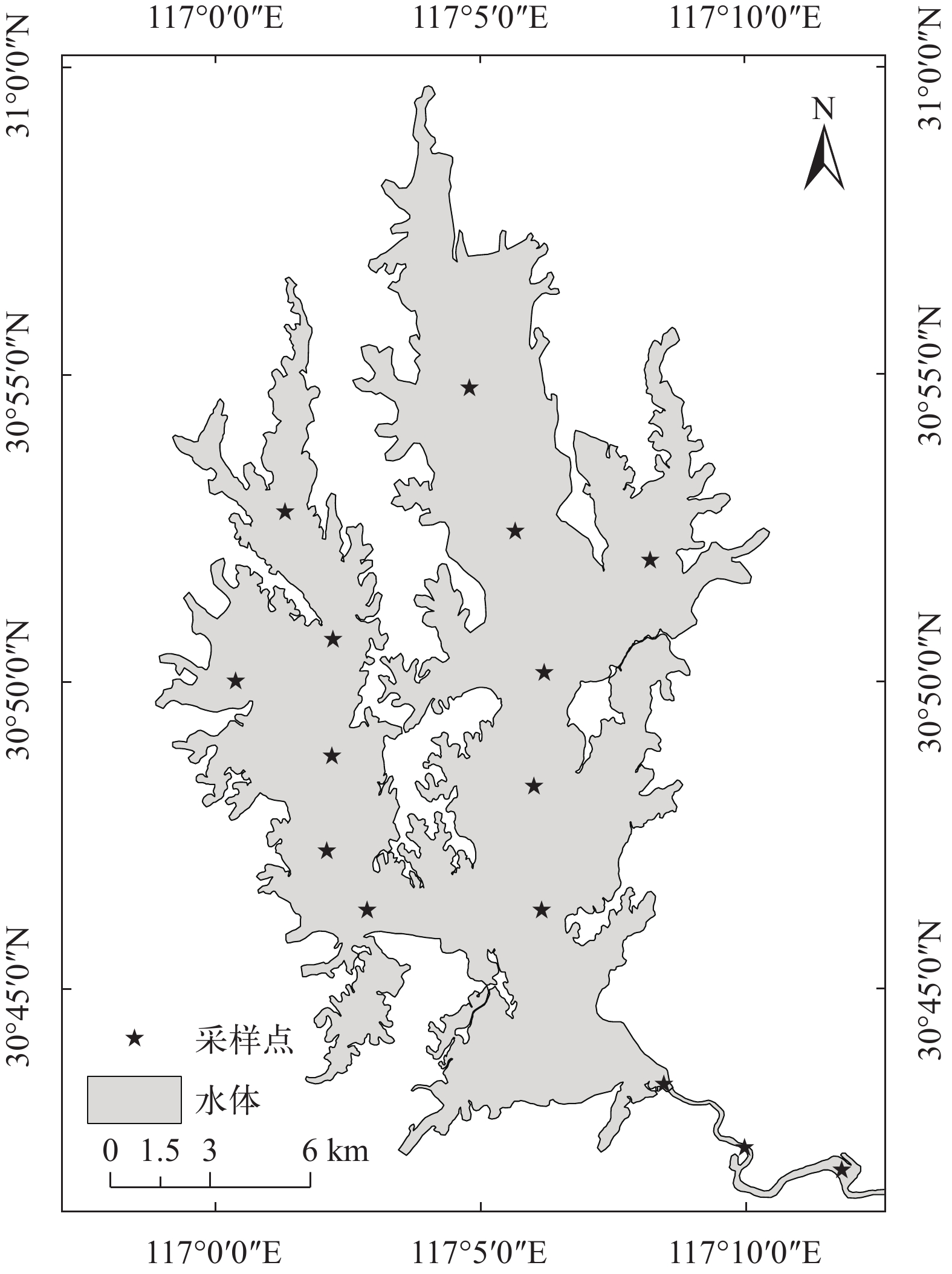
 下载:
下载:
